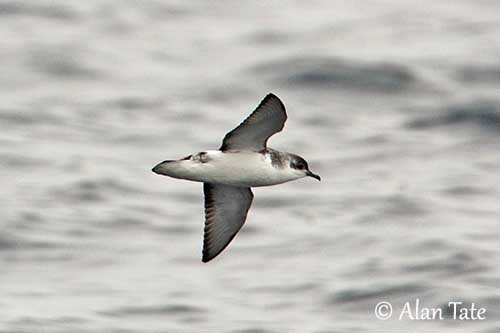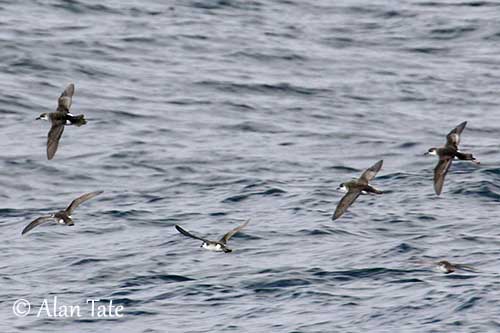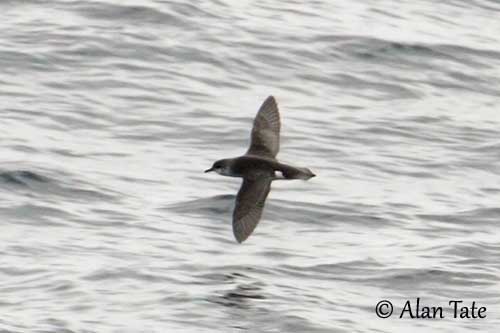
Fr: Petit Puffin
Ang: Little Shearwater
All: Kleiner Sturmtaucher
Esp: Pampero Chico
Ita: Berta minore fosca
Nd: Pacifische Kleine Pijlstormvogel
Sd: Dvärglira
Photographer:
Alan & Ann Tate
AA Bird Photography
Text by Nicole Bouglouan
Sources :
HANDBOOK OF THE BIRDS OF THE WORLD vol 1 by Josep del Hoyo-Andrew Elliot-Jordi Sargatal - Lynx Edicions - ISBN: 8487334105
A Complete Guide to Antarctic Wildlife by Hadoram Shirihai and Illustrated by Brett Jarrett - Edited by Guy M. Kirwan - ALUL.A Press Oy, Finland - ISBN 9519894705
IUCN Redlist -Puffinus assimilis
Wikipedia, the free encyclopaedia
Department of Sustainability, Environment, Water, Population and Communities
Ocean Wanderers "Ride the Wave"
Page family Procellariidae
Summary cards
Little Shearwater
Puffinus assimilis
Procellariiformes Order – Procellariidae Family
INTRODUCTION:
The Little Shearwater is the smallest species of all shearwaters with a length of 28 centimetres. Formerly, this species had several subspecies spread over the wide range, but now, only five subspecies are recognized.
It is fairly sedentary and more aquatic in its feeding behaviour, involving short, broad wings and stocky body.
The Little Shearwater is threatened by introduced mammal predators on the breeding grounds, but today, several islands are predator-free. Degradation of the habitat and human disturbance, with in addition erosion of sand dunes that destroy the nesting burrows, make the species at risk in some parts of the range.
DESCRIPTION OF THE BIRD:
Biometrics:
Length: 28 cm (25-30 cm)
Wingspan: 58-67 cm
Weight: 140-275 g
The adult of nominate race has dark, almost black upperparts, including head, upperwing and tail. The hindneck may appear paler.
The underparts are white but we can see a narrow black margin on the underwing. The white of the underparts extends upwards to the sides of the rump.
On the head, face and narrow supercilium are white, whereas the eye’s area shows dark spotting in front of the eye and on the upper ear-coverts. The sides of lower neck and upper breast are dark grey with some white flecking.
The bill is blackish with blue-grey base. The eyes are dark brown. Legs and webbed feet are bluish with some blackish on the outer side of the tarsus and outer toe, and mostly pinkish webs.
Male and female are similar, but the female has shorter tail.
The juvenile resembles adults.

SUBSPECIES AND RANGE:
The Little Shearwater has five subspecies recognized.
P.a. tunneyi occurs in S Australian seas, and breeds on islands off SW Australia. This race is especially small but resembles nominate.
P.a. assimilis (described above) is found in Tasman Sea, and breeds on Lord Howe and Norfolk islands.
P.a. elegans (displayed) or Subantarctic Little Shearwater breeds in Tristan da Cunha group and Gough Island (Atlantic), and on Chatham and Antipodes Islands (Pacific). There is possibly an unknown Chilean breeding population off Chile.
This race is larger than nominate, with more or less scaly blackish upperparts. On the head, the white supercilium is absent, and the face is dark, extending below the eye. The underwing is white with narrow, dark trailing edge.
P.a. kermadecensis occurs on Kermadec Islands and adjacent seas.
P.a. haurakiensis is found in New Zealand seas S to Cook Strait. It breeds on islands off NE North Island (NZ).
The two latter races resemble “elegans” but with slightly different face pattern.
HABITAT:
The Little Shearwater breeds on offshore and oceanic islands. It nests on grassy slopes and within forests, according to the island.
Outside breeding, it occurs on warm, tropical and subtropical waters, and it is more often seen on inshore waters than other shearwaters.
CALLS AND SONGS: SOUNDS BY XENO-CANTO
Like other Procellariidae, the Little Shearwater is usually silent at sea. It becomes more vocal at night at colonies where it gives typical, fairly loud, harsh calls, a repeated hoarse, asthmatic series “wah-i-wah-i-wah-ooo”.
Another description of the calls indicates a loud, rapidly repeated call such as “kakakakakakak-urr”, with the last syllable given by an almost breathless bird. These calls are given both in flight and from the ground near the burrow.
BEHAVIOUR IN THE WILD:
The Little Shearwater feeds mainly on cephalopods, small fish and krill. It catches the preys near the surface by dropping from the air, or by seizing it from the surface, or by chasing it in shallow dives.
It is not very gregarious and often forages alone, but it may sometimes associate with dolphins. Flocks can be seen offshore from breeding colonies.

The Little Shearwater nests in burrows, often under scrub or forest. It is territorial around the burrow entrance. Like numerous Procellariidae, they are probably monogamous with long-term pair-bonds.
This species tends to remain around its breeding colonies almost all year round, and it is considered fairly sedentary, visiting the colonies even outside the breeding season. However, immatures may perform some dispersal.
The Little Shearwater flies close to the water while foraging for preys. It glides effortlessly above the waves, gaining speed with the wind at different levels.
This small seabird flies swiftly in strong wings, but in light breezes, it flies low over the water with whirring wingbeats interspersed with glides.
REPRODUCTION OF THIS SPECIES:
The breeding season takes place during the local summer and varies according to the range. The birds perform a pre-laying exodus of about one month. They are colonial nesters and can be affected by competition for nesting sites with other seabirds.
The nest is a self-excavated burrow of 30 to 200 centimetres long, a fragile construction dug into very friable soil. The burrow is lined with sparse materials. It is found in coastal forest, scrub or tussac grass, on grassy slopes or within forest.
The Little Shearwater may also nest in rock crevices or among boulders, depending on nest-site availability.
The female lays a single white egg and both adults incubate during 52-58 days, with stints of 2 days in W Australia, and 7-10 days in New Zealand. At hatching, the chick has grey down. It is brooded for 3-4 days and fed at night by both parents. It fledges about 70-75 days after hatching. It usually reaches the peak mass at 45-48 days of age.
The Little Shearwater produces a single brood per season, and both adults share all the nesting duties.

PROTECTION / THREATS / STATUS:
The Little Shearwater is threatened by introduced predators (cats, rats and mice), and human disturbance, both involving declines of the population and even local extinctions.
The burrows are very fragile when dug in friable soil where they can be crushed by people walking within the breeding colonies. Degradation of the breeding habitat by erosion of the sand dunes is another problem. Cessation of human exploitation for eggs and meat is also recommended, because this species is becoming rare in some places.
However, eradication of Pacific rats from several breeding islands in New Zealand allows a conservation ranking of Recovering.
The population is estimated to number 300,000/750,000 individuals and decreasing. But currently, the Little Shearwater is still evaluated as Least Concern. (IUCN Redlist -Puffinus assimilis)